Water–Energy–Food Nexus and Life Cycle Thinking: A New Approach to Environmental and Nutritional Assessment of Potato Chips
Abstract
:1. Introduction
2. Materials and Methods
2.1. Goal and Scope
2.2. Data Collection, Hypothesis, and Life Cycle Inventory
2.3. Environmental Impact Calculation
2.4. Nutritional Quality Estimation
3. Results
WEF Nexus in Potato Chip Production
4. Opportunities for Improvement and Recommendations
4.1. Implementation of Drip Irrigation
4.2. Application of Natural Gas and Pellets as Heat Source in Processing
4.3. Replacement of the Conventional Oil Fryer with a Hot-Air Fryer
5. Limitations and Perspectives
6. Conclusions
Author Contributions
Funding
Institutional Review Board Statement
Informed Consent Statement
Acknowledgments
Conflicts of Interest
Appendix A
| Foreground Data | Process of the Ecoinvent or Agribalyse Databases |
|---|---|
| Potato seeds | Potato seed, at farm {GLO} productionAPOS, U |
| Water | Tap water {ES} market forAPOS, U |
| Fertilizer | Potassium nitrate {RER} market for APOS, U Fertilizing, by broadcaster {GLO} market for APOS, U |
| Pesticide | Pesticide, unspecified {RER} production APOS, U Application of plant protection product, by field sprayer {GLO} market for APOS, U |
| Diesel (agricultural machinery) | Diesel, burned in agricultural machinery {GLO} diesel, burned in agricultural machinery APOS, U |
| Land | Transformation, from permanent crop, irrigated, extensive |
| Tractor (transport) | Transport, tractor and trailer, agricultural {CH} market for transport, tractor and trailer, agricultural APOS, U |
| Electricity | Electricity, medium voltage {ES} market for APOS, S |
| Sunflower oil | Sunflower oil, processed in FR Ambient (long) PET at supermarket/FR |
| Salt | Salt {GLO} market for salt APOS, U |
| Diesel (generator) | Diesel, burned in diesel-electric generating set, 18.5 kW {GLO} diesel, burned in diesel-electric generating set, 18.5 kW APOS, U |
| Cardboard | Corrugated board box {RER} market for corrugated board box APOS, U |
| Polypropylene | Polypropylene, granulate {RER} production APOS, U |
| Film | Packaging film, low density polyethylene {RER} production APOS, U |
| Van (distribution) | Transport, freight, lorry 3.5–7.5 metric ton, euro6 {RER} market for transport, freight, lorry 3.5–7.5 metric ton, EURO6 APOS, U |
| Wastewater treatment | Wastewater, average {Europe without Switzerland} market for wastewater, average APOS, U |
| Cardboard waste treatment | Waste paperboard {ES} market for waste paperboard APOS, U |
| Polypropylene waste treatment | Waste polypropylene {ES} market for waste polypropylene APOS, U |
References
- Kowalczyk, Z. Life cycle assessment (LCA) of potato production. E3S Web Conf. 2019, 132, 02003. [Google Scholar] [CrossRef] [Green Version]
- FAOSTAT. Available online: http://www.fao.org/faostat/en/#data (accessed on 28 April 2021).
- Haverkort, A.; Struik, P. Yield levels of potato crops: Recent achievements and future prospects. Field Crop. Res. 2015, 182, 76–85. [Google Scholar] [CrossRef]
- Campos, H.; Ortiz, O. The Potato Crop. Its Agricultural, Nutritional and Social Contribution to Humankind; Springer: Berlin/Heidelberg, Germany, 2020. [Google Scholar]
- Mili, S.; Martínez-Vega, J. Accounting for Regional Heterogeneity of Agricultural Sustainability in Spain. Sustainability 2019, 11, 299. [Google Scholar] [CrossRef] [Green Version]
- Anuario de Estadística 2019; Report; MAPAMA Spanish Ministry of Agriculture, Fisheries and Food: Madrid, Spain, 2019.
- Informe del Consumo de Alimentación en España 2019; Report; MAPAMA Spanish Ministry of Agriculture, Fisheries and Food: Madrid, Spain, 2019.
- Carvalho, M.; de Souza Grilo, M.M.; Abrahao, R. Comparison of greenhouse gas emissions relative to two frying processes for homemade potato chips. Environ. Prog. Sustain. Energy 2017, 37, 481–487. [Google Scholar] [CrossRef]
- Zhang, P.; Cai, Y.; Zhou, Y.; Tan, Q.; Li, B.; Li, B.; Jia, Q.; Yang, Z. Quantifying the water-energy-food nexus in Guangdong, Hong Kong, and Macao regions. Sustain. Prod. Consum. 2022, 29, 188–200. [Google Scholar] [CrossRef]
- Hamidov, A.; Helming, K. Sustainability Considerations in Water–Energy–Food Nexus Research in Irrigated Agriculture. Sustainability 2020, 12, 6274. [Google Scholar] [CrossRef]
- Chang, Y.; Li, G.; Yao, Y.; Zhang, L.; Yu, C. Quantifying the Water-Energy-Food Nexus: Current Status and Trends. Energies 2016, 9, 65. [Google Scholar] [CrossRef] [Green Version]
- Mannan, M.; Al-Ansari, T.; Mackey, H.R.; Al-Ghamdi, S. Quantifying the energy, water and food nexus: A review of the latest developments based on life-cycle assessment. J. Clean. Prod. 2018, 193, 300–314. [Google Scholar] [CrossRef]
- Bolaños-Palmieri, C.; Jiménez-Morales, M.F.; Rojas-Vargas, J.; Arguedas-Camacho, M.; Brenes-Peralta, L. Food Loss and Waste Actions: Experiences of the Costa Rican Food Loss and Waste Reduction Network. Foods 2021, 10, 2358. [Google Scholar] [CrossRef]
- Laso, J.; Hoehn, D.; Margallo, M.; García-Herrero, I.; Batlle-Bayer, L.; Bala, A.; Fullana-I-Palmer, P.; Vázquez-Rowe, I.; Irabien, A.; Aldaco, R. Assessing Energy and Environmental Efficiency of the Spanish Agri-Food System Using the LCA/DEA Methodology. Energies 2018, 11, 3395. [Google Scholar] [CrossRef] [Green Version]
- Laso, J.; Margallo, M.; Fullana, P.; Bala, A.; Gazulla, C.; Irabien, A.; Aldaco, R. Introducing life cycle thinking to define best available techniques for products: Application to the anchovy canning industry. J. Clean. Prod. 2017, 155, 139–150. [Google Scholar] [CrossRef] [Green Version]
- Sala, S.; Anton, A.; McLaren, S.J.; Notarnicola, B.; Saouter, E.; Sonesson, U. In quest of reducing the environmental impacts of food production and consumption. J. Clean. Prod. 2017, 140, 387–398. [Google Scholar] [CrossRef]
- Zhang, C.; Chen, X.; Li, Y.; Ding, W.; Fu, G. Water-energy-food nexus: Concepts, questions and methodologies. J. Clean. Prod. 2018, 195, 625–639. [Google Scholar] [CrossRef]
- Moudrý, J.; Jelínkova, Z.; Jaresová, M.; Modrý, J.; Konvalina, P. Assessing greenhouse gas emissions from potato production and processing in the Czech Republic. Outlook Agric. 2013, 42, 179–183. [Google Scholar] [CrossRef] [Green Version]
- Parajuli, R.; Matlock, M.D.; Thoma, G. Cradle to grave environmental impact evaluation of the consumption of potato and tomato products. Sci. Total Environ. 2020, 758, 143662. [Google Scholar] [CrossRef] [PubMed]
- Frankowska, A.; Jeswani, H.K.; Azapagic, A. Environmental impacts of vegetables consumption in the UK. Sci. Total Environ. 2019, 682, 80–105. [Google Scholar] [CrossRef] [PubMed]
- Al-Ansari, T.; Korre, A.; Nie, Z.; Shah, N. Development of a life cycle assessment tool for the assessment of food production systems within the energy, water and food nexus. Sustain. Prod. Consum. 2015, 2, 52–66. [Google Scholar] [CrossRef]
- Jeswani, H.K.; Burkinshaw, R.; Azapagic, A. Environmental sustainability issues in the food–energy–water nexus: Breakfast cereals and snacks. Sustain. Prod. Consum. 2015, 2, 17–28. [Google Scholar] [CrossRef]
- Armengot, L.; Beltrán, M.J.; Schneider, M.; Simón, X.; Pérez-Neira, D. Food-energy-water nexus of different cacao production systems from a LCA approach. J. Clean. Prod. 2021, 304, 126941. [Google Scholar] [CrossRef]
- Ghani, H.U.; Silalertruksa, T.; Gheewala, S.H. Water-energy-food nexus of bioethanol in Pakistan: A life cycle approach evaluating footprint indicators and energy performance. Sci. Total Environ. 2019, 687, 867–876. [Google Scholar] [CrossRef]
- Pacetti, T.; Lombardi, L.; Federici, G. Water–energy Nexus: A case of biogas production from energy crops evaluated by Water Footprint and Life Cycle Assessment (LCA) methods. J. Clean. Prod. 2015, 101, 278–291. [Google Scholar] [CrossRef]
- Drewnowski, A. Defining Nutrient Density: Development and Validation of the Nutrient Rich Foods Index. J. Am. Coll. Nutr. 2009, 28, 421S–426S. [Google Scholar] [CrossRef] [PubMed]
- Santos, M.; Rito, A.I.; Matias, F.N.; Assunção, R.; Castanheira, I.; Loureiro, I. Nutrient profile models a useful tool to facilitate healthier food choices: A comprehensive review. Trends Food Sci. Technol. 2021, 110, 120–131. [Google Scholar] [CrossRef]
- Fernández-Ríos, A.; Laso, J.; Campos, C.; Ruiz-Salmón, I.; Hoehn, D.; Cristóbal, J.; Batlle-Bayer, L.; Bala, A.; Fullana-I-Palmer, P.; Puig, R.; et al. Towards a Water-Energy-Food (WEF) nexus index: A review of nutrient profile models as a fundamental pillar of food and nutrition security. Sci. Total Environ. 2021, 789, 147936. [Google Scholar] [CrossRef] [PubMed]
- ISO 14040; Environmental Management—Life Cycle Assessment—Principles and Framework. ISO: Madrid, Spain, 2006.
- McAuliffe, G.A.; Takahashi, T.; Lee, M. Applications of nutritional functional units in commodity-level life cycle assessment (LCA) of agri-food systems. Int. J. Life Cycle Assess. 2020, 25, 208–221. [Google Scholar] [CrossRef] [Green Version]
- Martin-Gorriz, B.; Gallego-Elvira, B.; Martínez-Alvarez, V.; Maestre-Valero, J. Life cycle assessment of fruit and vegetable production in the Region of Murcia (south-east Spain) and evaluation of impact mitigation practices. J. Clean. Prod. 2020, 265, 121656. [Google Scholar] [CrossRef]
- Ecoinvent Database. Available online: https://ecoinvent.org/the-ecoinvent-database/ (accessed on 18 February 2022).
- Parvatker, A.G.; Eckelman, M.J. Comparative Evaluation of Chemical Life Cycle Inventory Generation Methods and Implications for Life Cycle Assessment Results. ACS Sustain. Chem. Eng. 2019, 7, 350–367. [Google Scholar] [CrossRef]
- Torabian, S.; Farhangi-Abriz, S.; Qin, R.; Noulas, C.; Sathuvalli, V.; Charlton, B.; Loka, D. Potassium: A Vital Macronutrient in Potato Production—A Review. Agronomy 2021, 11, 543. [Google Scholar] [CrossRef]
- Le Roux, B.; Van Der Laan, M.; Gush, M.B.; Bristow, K.L. Comparing the usefulness and applicability of different water footprint methodologies for sustainable water management in agriculture. Irrig. Drain. 2018, 67, 790–799. [Google Scholar] [CrossRef]
- Boulay, A.-M.; Bare, J.; Benini, L.; Berger, M.; Lathuillière, M.J.; Manzardo, A.; Margni, M.; Motoshita, M.; Nunez, M.; Pastor, A.V.; et al. The WULCA consensus characterization model for water scarcity footprints: Assessing impacts of water consumption based on available water remaining (AWARE). Int. J. Life Cycle Assess. 2018, 23, 368–378. [Google Scholar] [CrossRef] [Green Version]
- Ansorge, L.; Beránková, T. LCA Water Footprint AWARE Characterization Factor Based on Local Specific Conditions. Eur. J. Sustain. Dev. 2017, 6, 13–20. [Google Scholar] [CrossRef]
- Morelli, B.; Hawkins, T.R.; Niblick, B.; Henderson, A.D.; Golden, H.E.; Compton, J.E.; Cooter, E.J.; Bare, J.C. Critical Review of Eutrophication Models for Life Cycle Assessment. Environ. Sci. Technol. 2018, 52, 9562–9578. [Google Scholar] [CrossRef] [PubMed]
- Manfredi, S.; Allacker, K.; Pelletier, N.; Schau, E.; Chomkhamsri, K.; Pant, R.; Pennington, D. Comparing the European Commission product environmental footprint method with other environmental accounting methods. Int. J. Life Cycle Assess. 2015, 20, 389–404. [Google Scholar] [CrossRef]
- Schulze, R.; Guinée, J.; van Oers, L.; Alvarenga, R.; Dewulf, J.; Drielsma, J. Abiotic resource use in life cycle impact assessment—Part I—towards a common perspective. Resour. Conserv. Recycl. 2020, 154, 104596. [Google Scholar] [CrossRef]
- Drewnoswki, A. The nutrient rich foods index helps to identify healthy, affordable foods. Am. J. Clin. Nutr. 2010, 31, 1095S–1101S. [Google Scholar] [CrossRef]
- BEDCA. Spanish Food Composition Database. Available online: https://www.bedca.net/bdpub/ (accessed on 13 December 2021).
- European Commission. Regulation (EU) No 1169/2011 of the European Parliament and of the Council of 25 October 2011 on the Provision of Food Information to Consumers. 2011. Available online: https://eur-lex.europa.eu/legal-content/EN/ALL/?uri=celex%3A32011R1169 (accessed on 20 February 2022).
- Dietary Reference Values for Nutrients; Summary Report; EFSA: Parma, Italy, 2017.
- Ridoutt, B.; Sanguansri, P.; Bonney, L.; Crimp, S.; Lewis, G.; Lim-Camacho, L. Climate Change Adaptation Strategy in the Food Industry—Insights from Product Carbon and Water Footprints. Climate 2016, 4, 26. [Google Scholar] [CrossRef] [Green Version]
- Ponsioen, T.; Blonk, H. Case Studies for More Insight into the Methodology and Composition of Carbon Footprints of Table Potatoes and Chips; Report; Blonk Environmental Consultants: Gouda, The Netherlands, 2011. [Google Scholar]
- Hess, J.M.; Slavin, J.L. Healthy Snacks: Using Nutrient Profiling to Evaluate the Nutrient-Density of Common Snacks in the United States. J. Food Sci. 2017, 82, 2213–2220. [Google Scholar] [CrossRef]
- Hess, J.; Rao, G.; Slavin, J. The Nutrient Density of Snacks: A comparison of Nutrient Profiles of Popular Snack Foods Using the Nutrient-Rich Foods Index. Glob. Ped. Health 2017, 4, 1–6. [Google Scholar] [CrossRef] [Green Version]
- Gupta, S.; Hawk, T.; Aggarwal, A.; Drewnowski, A. Characterizing Ultra-Processed Foods by Energy Density, Nutrient Density, and Cost. Front. Nutr. 2019, 6, 70. [Google Scholar] [CrossRef] [Green Version]
- Gültekin, R.; Ertek, A. Effects of deficit irrigation on the potato tuber development and quality. Int. J. Agric. Environ. Food Sci. 2018, 2, 93–102. [Google Scholar] [CrossRef]
- Badr, M.A.; Abou-Hussein, S.; El-Tohamy, W.; Gruda, N. Efficiency of Subsurface Drip Irrigation for Potato Production under Different Dry Stress Conditions. Gesunde Pflanz. 2010, 62, 63–70. [Google Scholar] [CrossRef]
- Djaman, K.; Irmak, S.; Koudahe, K.; Allen, S. Irrigation management in potato (Solanum tuberosum L.) production: A review. Sustainability 2021, 13, 1504. [Google Scholar] [CrossRef]
- Qin, J.; Ramírez, D.A.; Xie, K.; Li, W.; Yactayo, W.; Jin, L.; Quiroz, R. Is Partial Root-Zone Drying More Appropriate than Drip Irrigation to Save Water in China? A Preliminary Comparative Analysis for Potato Cultivation. Potato Res. 2018, 61, 391–406. [Google Scholar] [CrossRef] [Green Version]
- Pajewski, T.; Malak-Rawlikowska, A.; Golebiewska, B. Measuring regional diversification of environmental externalities in agriculture and the effectiveness of their production by EU agri-environmental programs in Poland. J. Clean. Prod. 2020, 276, 123013. [Google Scholar] [CrossRef]
- Gao, D.; Qiu, X.; Zheng, X.; Zhang, Y. Life cycle analysis of coal-based synthetic natural gas for heat supply and electricity generation in China. Chem. Eng. Res. Des. 2018, 131, 709–722. [Google Scholar] [CrossRef]
- Riva, A.; D’Angelosante, S.; Trebeschi, C. Natural gas and the environmental results of life cycle assessment. Energy 2006, 31, 138–148. [Google Scholar] [CrossRef]
- Nunes, L.; Matias, J.; Catalão, J.P.S. Biomass in the generation of electricity in Portugal: A review. Renew. Sustain. Energy Rev. 2017, 71, 373–378. [Google Scholar] [CrossRef]
- Martín-Gamboa, M.; Marques, P.; Freire, F.; Arroja, L.; Dias, A.C. Life cycle assessment of biomass pellets: A review of methodological choices and results. Renew. Sustain. Energy Rev. 2020, 133, 110278. [Google Scholar] [CrossRef]
- Abd Rahman, N.A.; Abdul Razak, S.; Lokmanalhakim, L.; Taip, F.; Mustapa Kamal, S. Response surface optimization for hot air-frying technique and its effects on the quality of sweet potato snack. J. Food Process. Eng. 2017, 40, e12507. [Google Scholar] [CrossRef]
- Garcia-Herrero, I.; Margallo, M.; Laso, J.; Batlle-Bayer, L.; Bala, A.; Fullana-I-Palmer, P.; Vazquez-Rowe, I.; Gonzalez, M.; Amo-Setien, F.; Durá, M.; et al. Nutritional data management of food losses and waste under a life cycle approach: Case study of the Spanish agri-food system. J. Food Compos. Anal. 2019, 82, 103223. [Google Scholar] [CrossRef]
- Drexler, D.; Fiala, J.; Havlíčková, A.; Potůčková, A.; Souček, M. The Effect of Organic Food Labels on Consumer Attention. J. Food Prod. Mark. 2017, 24, 441–455. [Google Scholar] [CrossRef]
- Miranda-Ackerman, M.A.; Azzaro-Pantel, C. Extending the scope of eco-labelling in the food industry to drive change beyond sustainable agriculture practices. J. Environ. Manag. 2017, 204, 814–824. [Google Scholar] [CrossRef] [PubMed] [Green Version]
- Lusk, J.L.; McCluskey, J. Understanding the Impacts of Food Consumer Choice and Food Policy Outcomes. Appl. Econ. Perspect. Policy 2018, 40, 5–21. [Google Scholar] [CrossRef] [Green Version]
- Albrecht, T.R.; Crootof, A.; Scott, C.A. The Water-Energy-Food Nexus: A systematic review of methods for nexus assessment. Environ. Res. Lett. 2018, 13, 043002. [Google Scholar] [CrossRef]
- Van der Giesen, C.; Cucurachi, S.; Guinée, J.; Kramer, G.J.; Tukker, A. A critical vie won the current application of LCA for new technologies and recommendation for improved practice. J. Clean. Prod. 2020, 259, 120904. [Google Scholar] [CrossRef]
- Crawford, R.H.; Bontinck, P.-A.; Stephan, A.; Wiedmann, T.; Yu, M. Hybrid life cycle inventory methods—A review. J. Clean. Prod. 2018, 172, 1273–1288. [Google Scholar] [CrossRef]
- Curran, M.A. Strengths and Limitations of Life Cycle Assessment. In Background and Future Prospects in Life Cycle Assessment; Springer: Dordrecht, The Netherlands, 2014. [Google Scholar]
- Frischknecht, R.; Wyss, F.; Büsser Knöpfel, S.; Lützkendorf, T.; Balouktsi, M. Cumulative energy demand in LCA: The energy harvested approach. Int. J. Life Cycle Assess. 2015, 20, 957–969. [Google Scholar] [CrossRef]
- Guinée, J.B.; Gorrée, M.; Heijungs, R.; Huppes, G.; Kleijn, R.; De Koning, A.; Oers, L.V.; Wegener, S.A.; Suh, S.; Udo de Haes, H.A.; et al. I: LCA in Perspective. IIa: Guide. IIb: Operational Annex. III: Scientific Background. In Handbook on Life Cycle Assessment. Operational Guide to the ISO Standards; Kluwer Academic Publishers: Dordrecht, The Netherlands, 2002; p. 692. [Google Scholar]
- Hoekstra, A.Y. A critique on the water-scarcity weighted water footprint in LCA. Ecol. Indic. 2016, 66, 564–573. [Google Scholar] [CrossRef] [Green Version]
- Laso, J.; Margallo, M.; García-Herrero, I.; Fullana, P.; Bala, A.; Gazulla, C.; Polettini, A.; Kahhat, R.; Vázquez-Rowe, I.; Irabien, A.; et al. Combined application of life cycle assessment and lineal programming to evaluate food waste-to-food strategies: Seeking for answers in the nexus approach. Waste Manag. 2018, 80, 186–197. [Google Scholar] [CrossRef]
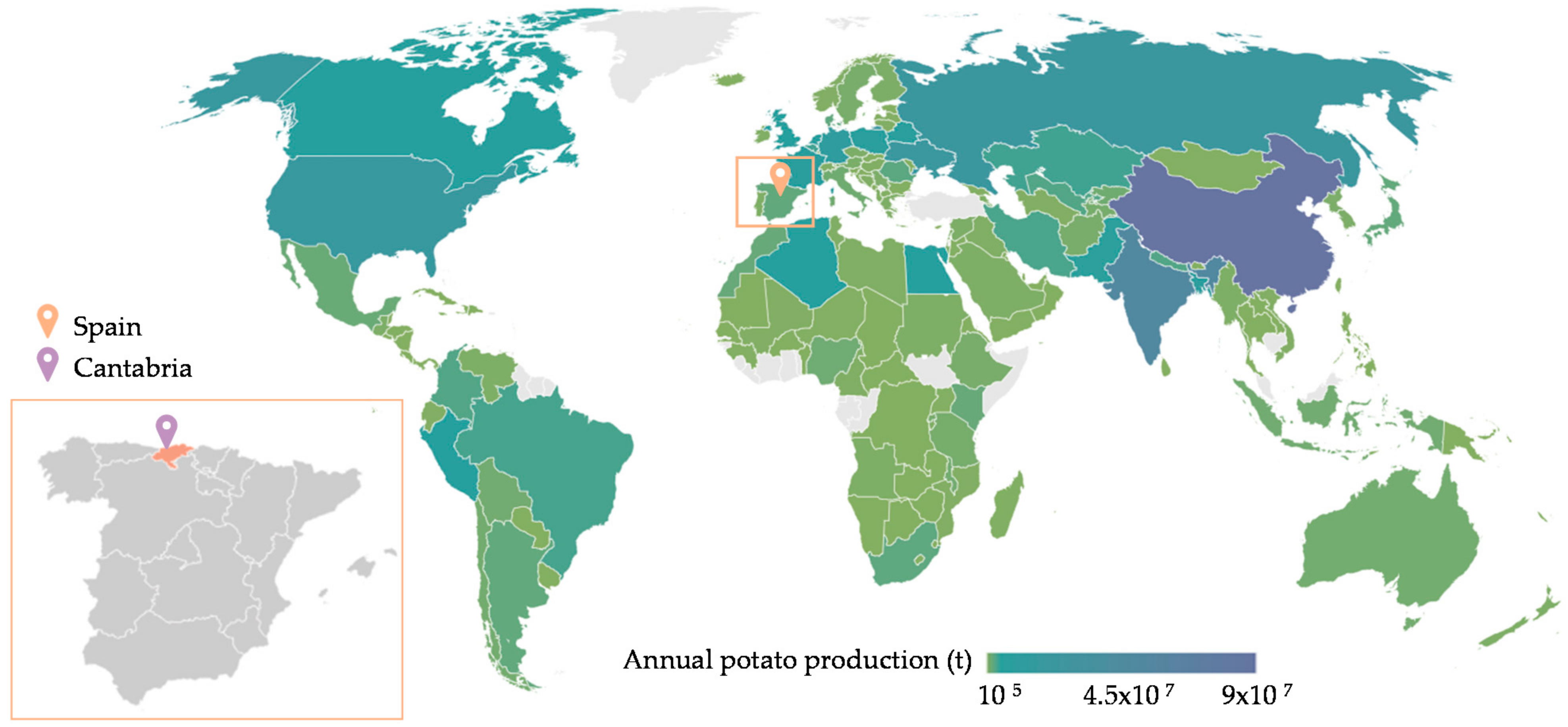

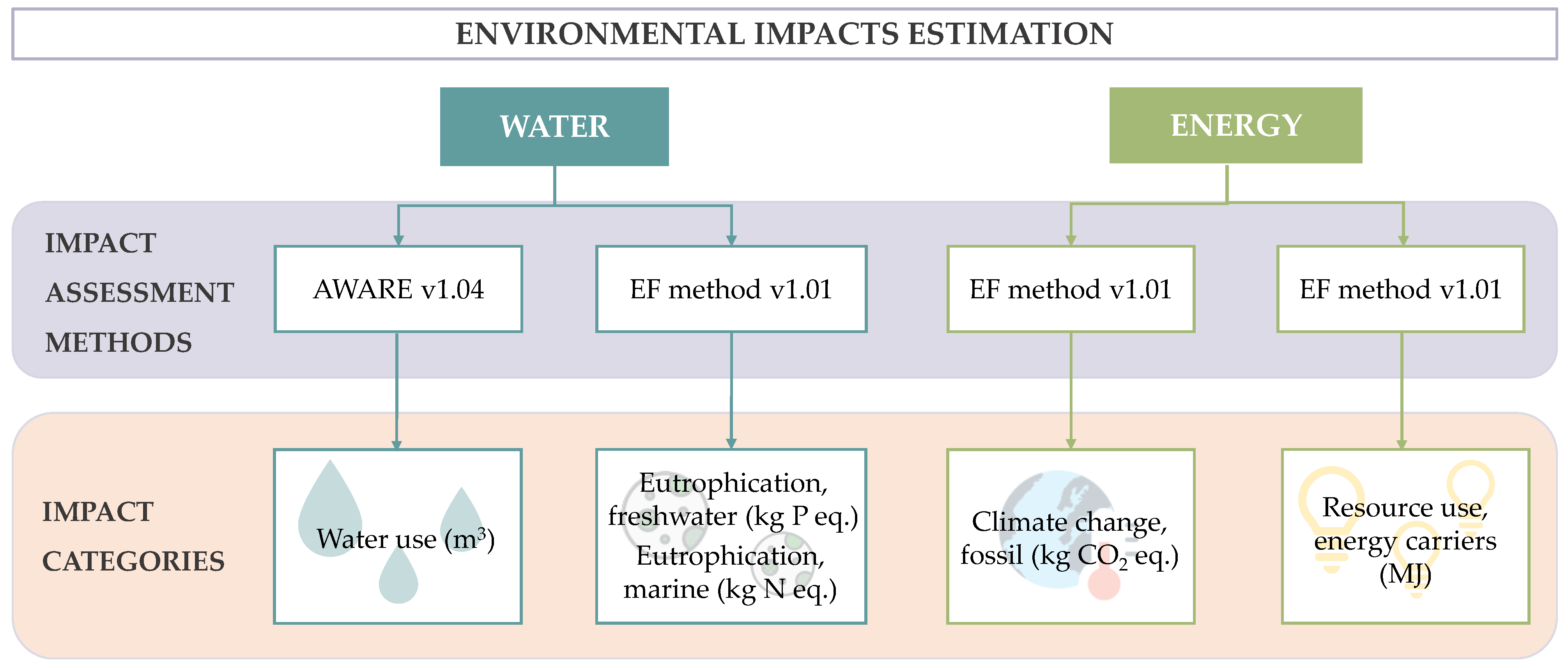
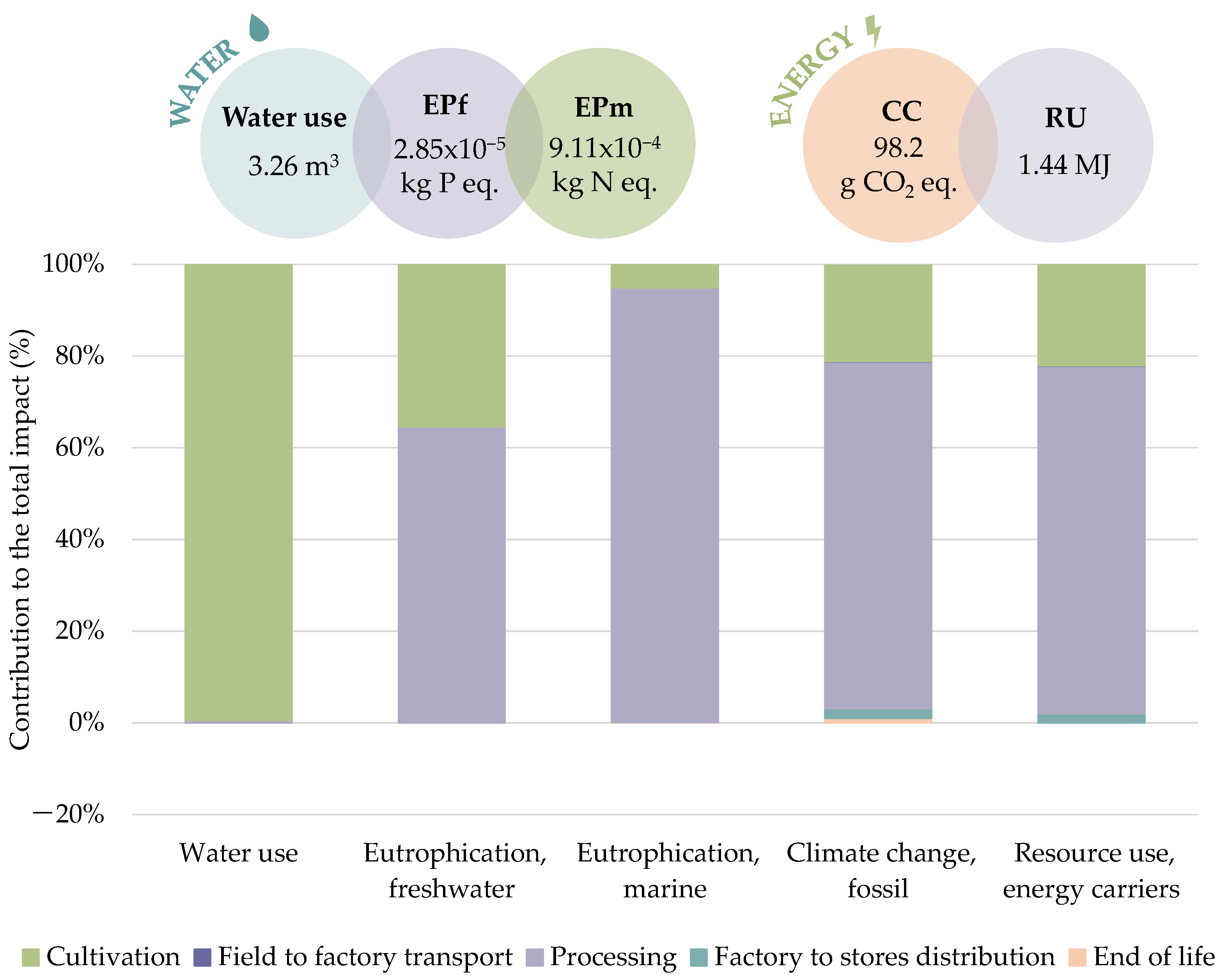



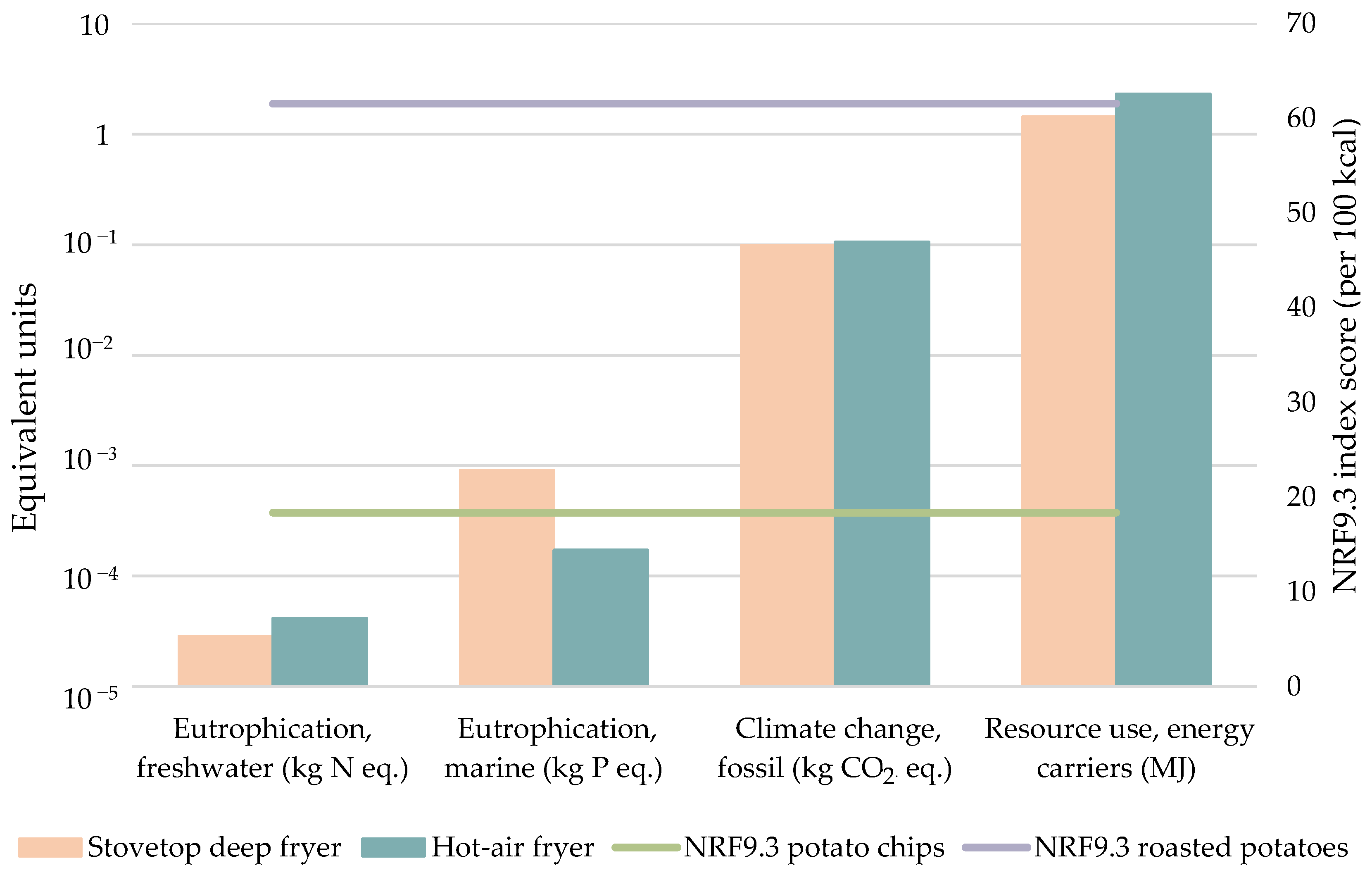
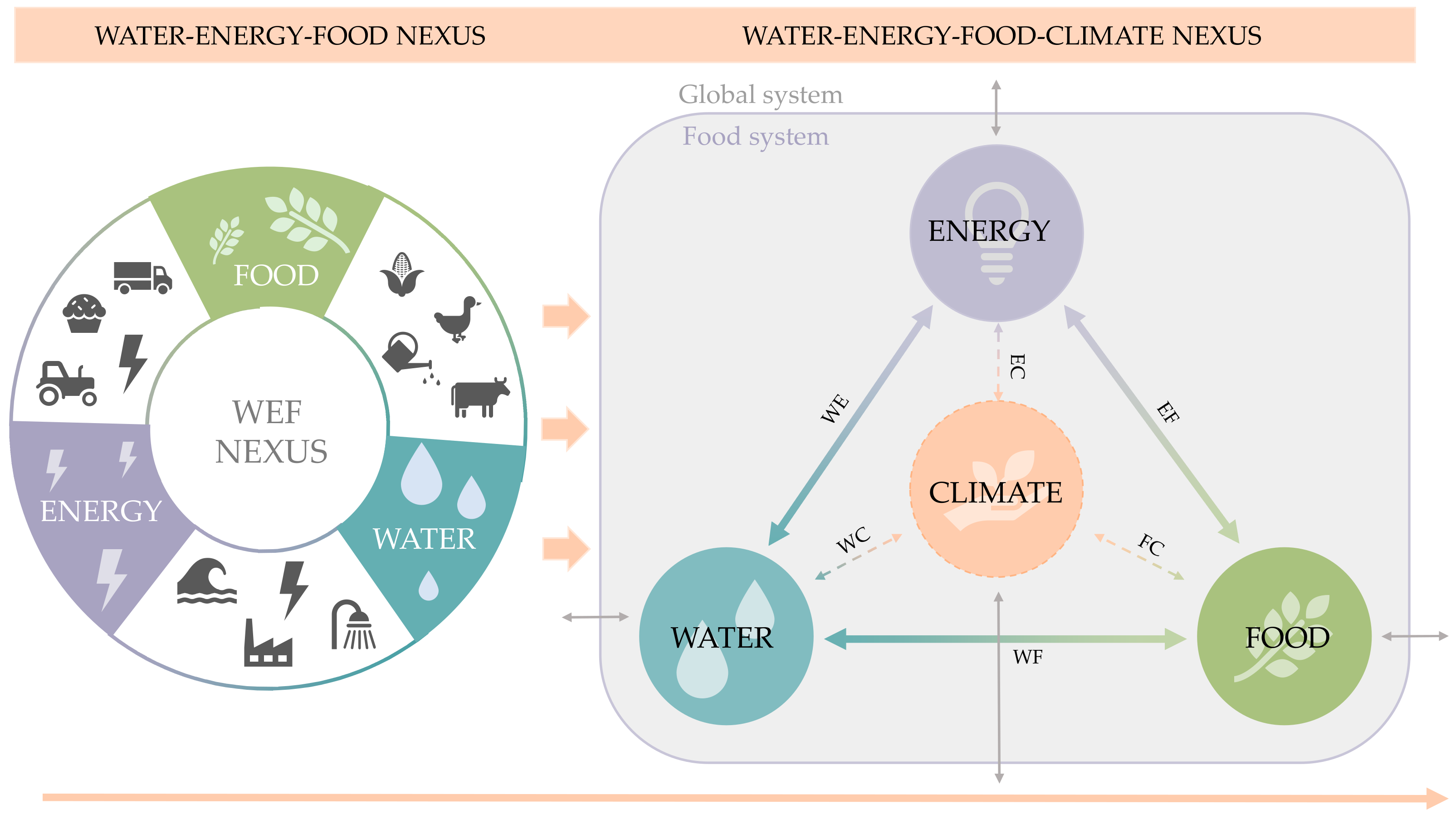
| Cultivation—Inputs from Technosphere | |||||
|---|---|---|---|---|---|
| Material | Unit | Value | Material | Unit | Value |
| Potato seeds | kg | 1.60 × 10−2 | Insecticide | kg | 2.00 × 10−6 |
| Water | L | 40.00 | Diesel | L | 7.20 × 10−4 |
| Fertilizer | kg | 2.24 × 10−3 | |||
| Cultivation—Inputs from Nature | Cultivation—Outputs to Technosphere | ||||
| Material | Unit | Value | Product | Unit | Value |
| Land | Ha | 8.00 × 10−6 | Harvested potatoes | kg | 2.00 × 10−1 |
| Transport—Inputs from Technosphere | |||||
| Material | Unit | Value | |||
| Raw potatoes | kg × km | 6.00 × 10−1 | |||
| Processing—Inputs from Technosphere | |||||
| Material | Unit | Value | Material | Unit | Value |
| Electricity production | kWh | 6.50 × 10−4 | Salt | kg | 1.00 × 10−4 |
| Electricity packaging | kWh | 3.90 × 10−3 | Cardboard | kg | 1.13 × 10−3 |
| Water | L | 3.24 × 10−2 | Polypropylene | kg | 1.62 × 10−3 |
| Sunflower oil | L | 1.66 × 10−2 | Film | kg | 3.20 × 10−6 |
| Processing—Outputs to Technosphere | |||||
| Product | Unit | Value | Product | Unit | Value |
| Potato chips (50 g bag) | kg | 5.00 × 10−2 | Potato chips (140 g bag) | kg | 1.00 × 10−1 |
| Used oil | L | 1.62 × 10−3 | |||
| Waste to treatment | Unit | Value | Waste to treatment | Unit | Value |
| Potato discards | kg | 3.15 × 10−3 | Cardboard | kg | 2.40 × 10−4 |
| Film | kg | 3.20 × 10−6 | Wastewater | L | 3.24 × 10−2 |
| Distribution—Inputs from Technosphere | Consumption—Outputs to Technosphere | ||||
| Material | Unit | Value | Waste to treatment | Unit | Value |
| Potato chips bags | kg·km | 5.00 | Polypropylene | kg | 1.62 × 10−3 |
| Potato Chips a | DV | MRV b | |
|---|---|---|---|
| Protein | 6.5 g | 50 g b | - |
| Fiber | 4 g | 25 g c | - |
| Vitamin A | 0 µg | 800 µg b | - |
| Vitamin C | 10 mg | 80 mg b | - |
| Vitamin E | 4 mg | 12 mg b | - |
| Ca | 37 mg | 800 mg b | - |
| Fe | 2 mg | 14 mg b | - |
| K | 1190 mg | 2000 mg b | - |
| Mg | 50 mg | 375 mg b | - |
| Saturated fats | 7.7 g | - | 20 g |
| Added sugar | 0 mg | - | 50 mg |
| Na | 700 mg | - | 2400 mg |
Publisher’s Note: MDPI stays neutral with regard to jurisdictional claims in published maps and institutional affiliations. |
© 2022 by the authors. Licensee MDPI, Basel, Switzerland. This article is an open access article distributed under the terms and conditions of the Creative Commons Attribution (CC BY) license (https://creativecommons.org/licenses/by/4.0/).
Share and Cite
Fernández-Ríos, A.; Laso, J.; Amo-Setién, F.J.; Abajas-Bustillo, R.; Ortego-Mate, C.; Fullana-i-Palmer, P.; Bala, A.; Batlle-Bayer, L.; Balcells, M.; Puig, R.; et al. Water–Energy–Food Nexus and Life Cycle Thinking: A New Approach to Environmental and Nutritional Assessment of Potato Chips. Foods 2022, 11, 1018. https://doi.org/10.3390/foods11071018
Fernández-Ríos A, Laso J, Amo-Setién FJ, Abajas-Bustillo R, Ortego-Mate C, Fullana-i-Palmer P, Bala A, Batlle-Bayer L, Balcells M, Puig R, et al. Water–Energy–Food Nexus and Life Cycle Thinking: A New Approach to Environmental and Nutritional Assessment of Potato Chips. Foods. 2022; 11(7):1018. https://doi.org/10.3390/foods11071018
Chicago/Turabian StyleFernández-Ríos, Ana, Jara Laso, Francisco José Amo-Setién, Rebeca Abajas-Bustillo, Carmen Ortego-Mate, Pere Fullana-i-Palmer, Alba Bala, Laura Batlle-Bayer, Merce Balcells, Rita Puig, and et al. 2022. "Water–Energy–Food Nexus and Life Cycle Thinking: A New Approach to Environmental and Nutritional Assessment of Potato Chips" Foods 11, no. 7: 1018. https://doi.org/10.3390/foods11071018
APA StyleFernández-Ríos, A., Laso, J., Amo-Setién, F. J., Abajas-Bustillo, R., Ortego-Mate, C., Fullana-i-Palmer, P., Bala, A., Batlle-Bayer, L., Balcells, M., Puig, R., Aldaco, R., & Margallo, M. (2022). Water–Energy–Food Nexus and Life Cycle Thinking: A New Approach to Environmental and Nutritional Assessment of Potato Chips. Foods, 11(7), 1018. https://doi.org/10.3390/foods11071018











